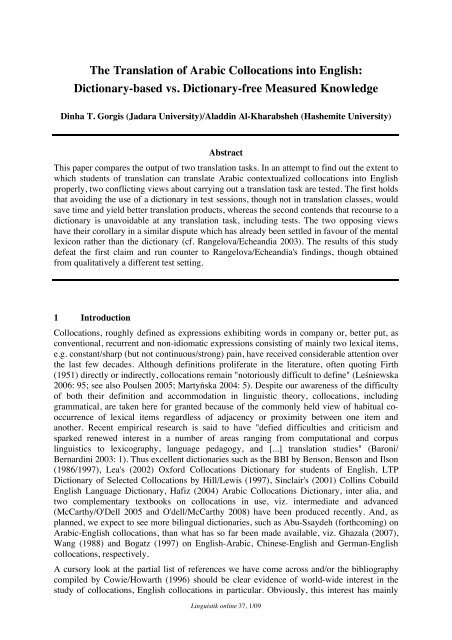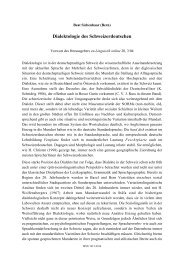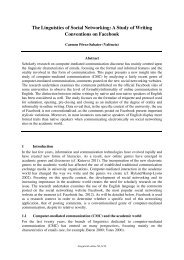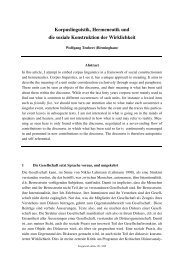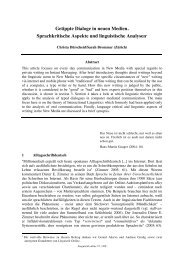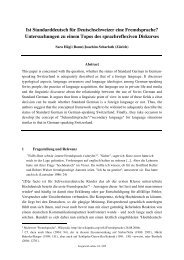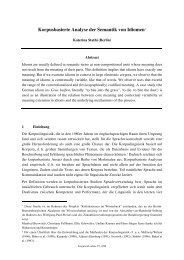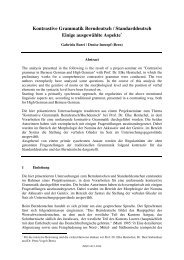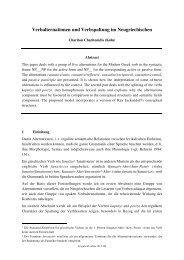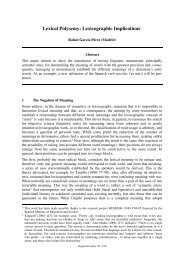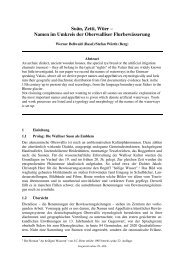The Translation of Arabic Collocations into English - Linguistik online
The Translation of Arabic Collocations into English - Linguistik online
The Translation of Arabic Collocations into English - Linguistik online
You also want an ePaper? Increase the reach of your titles
YUMPU automatically turns print PDFs into web optimized ePapers that Google loves.
Dinha T. Gorgis & Aladdin Al-Kharabsheh: <strong>Translation</strong> <strong>of</strong> <strong>Arabic</strong> <strong>Collocations</strong> <strong>into</strong> <strong>English</strong>23claims that recourse to a dictionary is unavoidable at any stage <strong>of</strong> training undergraduates,including examinations.<strong>The</strong> underlying assumption here is that, according to the dictionary-based view, trainingtranslators will skim the readily accessible dictionary entries in search for the most adequateand reliable equivalents. <strong>The</strong> dictionary-free view contends that trainees will skimtranslational correspondences, including lexical relations as stored in their mental lexicon, inno time. Not only this, but holds that "the human word-store contains far, far moreinformation about each lexical entry" (Rangelova/Echeandia 2003). Indeed, this is bound topresent conflicting entailments. <strong>The</strong> former, for instance, seems to entail the likelihood, on thepart <strong>of</strong> an equivalent-finder, to resort to generally the first given dictionary entry, thus apredilection to venture down the path <strong>of</strong> literal translation could be tenable here. By contrast,the latter, which advocates a dictionary-free treatment <strong>of</strong> equivalence, seems to entail theability to skim and access the closest options, if already stored, in the mental lexicon; that is,the skimming process, though requiring more cognitive processing on the part <strong>of</strong> trainees, butless sight tracking, is more likely to result in a fewer selection <strong>of</strong> senses for the requiredlexical item and hence the choice <strong>of</strong> a functional equivalent that emerges in a relativelyshorter time span. In the first author's experience, the dictionary-based selection freedom is,accordingly, time-consuming because entry meanings in the general dictionaries madeavailable to novice translators in the class are not listed to well-defined criteria and objectivesand hence the indeterminacy and indecisiveness on the part <strong>of</strong> the proper sense finder. That adictionary-free task saves time is already implicitly acknowledged in James Cook University'sdocument on Policy and Procedures regarding "Student Access to a Dictionary During anExamination" 1 .<strong>The</strong> manual states the following: "Candidates using a bilingual <strong>English</strong> translation dictionaryare not permitted extra time to complete their examination." No wonder, it is reported that70% <strong>of</strong> the translation instructors in Saudi Arabia universities do not allow their students touse dictionaries in class or test sessions (cf. Al-Jarf 2001). In the second author's relativelyshorter experience, on the other hand, equal opportunities are <strong>of</strong>fered to trainees and/or testeesin an attempt to create a healthy "feel-free" class, not to mention the fact that it has beentraditionally held that dictionaries are authoritative, better sources for finding delicatemeanings and lexical associations than relying on intuition and stored knowledge in the mind.This view is by and large the norm on the current scene (cf. Ryu 2006; Maurer-Stroh 2004);dictionary use is more <strong>of</strong>ten than not recommended and encouraged.Incidentally, these two conflicting views have already been tested by Rangelova/Echeandia(2003) who hypothesized that "dictionary entries are not representative <strong>of</strong> the way humanslink words together in their minds" (2003: 2). <strong>The</strong>ir sample subjects for the study, whichincluded 16 dictionaries and a questionnaire on how learners use them, were 26 internationalstudents enrolled in the intermediate and advanced level ESL classes in the <strong>English</strong> Languageprogram at the University <strong>of</strong> Albany, New York. <strong>The</strong> students came from a diversity <strong>of</strong>countries representing eight different languages. <strong>The</strong>y concluded that dictionaries are limitedin scope in comparison with the mental lexicon and, therefore, "tend to overlook the waylexical items are interconnected in semantic memory" (ibd.). In an attempt to find outpreferences in employing the 16 dictionaries, their results showed that their subjects "chosethe definitions that included examples <strong>of</strong> the systematic collocational patterns <strong>of</strong> words as"most helpful" over definitions that did not contain collocations" (2003: 4).By extension, this paper purports to investigate the matter in an endeavour to settle the disputebetween the present researchers and, as a by-product, to verify the dictionary/mental lexicon1 http://www.jcu.edu.au/policy/allitoz/JCUDEV_005335.html.ISSN 1615-3014
28<strong>Linguistik</strong> <strong>online</strong> 37, 1/09limited that they were unable to provide as many senses as those given by group A. Yet whenit comes to the question <strong>of</strong> which (sub)group is closer to the 30 optimal translationscorresponding to the 30 <strong>Arabic</strong> sentences, we shall get a completely different picture. Table 4below summarizes the results:(Sub)groupNo. <strong>of</strong> studentsTotal no. <strong>of</strong> appropriatecollocationsISSN 1615-3014Average <strong>of</strong> appropriatecollocations per onestudent for a single itemA1 11 100 3.0B1 18 77 1.425A2 10 92 3.06B2 11 73 2.212A3 10 71 2.366B3 11 39 1.181A 31 263 2.827B 40 189 1.575Table 4: Total no. <strong>of</strong> appropriate collocations given by (sub)groups and average <strong>of</strong> appropriate collocationsfor a single lexical item given by one studentTable 4 should enable us to draw conclusions on the basis <strong>of</strong> comparing averages <strong>of</strong> selecteditems per one student in the (sub)group, irrespective <strong>of</strong> approximation to the required sense byeach <strong>of</strong> the 30 sentences (as shown in table 3), with those <strong>of</strong> table 4, viz. averages <strong>of</strong> selecteditems per one student in the (sub)group in regard to how close the students were to theoptimal sense relations. To draw a simple comparison more lucidly, an average student fromA1 sub-group, for example, can select 3.0 appropriate senses from the dictionary in anattempt to translate 10 collocations for a single lexical item on average, whereas an averagestudent from group B1 can retrieve from memory only 1.425. Without carrying out anystatistical test, it is crystal clear that the performance <strong>of</strong> subjects in B1 is doubly poor. Toreiterate, the students in B1, categorized as top, have just been judged tentatively that theyseem to be slightly better than those in A1, again top, because they selected fewer senses onaverage and hence assumed to be better guided by their linguistic repertoire, i.e., mentallexicon. But selecting fewer senses is by no means an indicator <strong>of</strong> better pr<strong>of</strong>iciency; for if wereversed the two settings, group A might have chosen fewer senses in the absence <strong>of</strong> adictionary. <strong>The</strong> same argument, however, applies to the rest <strong>of</strong> the sub-groups, a gloomypicture indeed. Yet it remains to say that he results are suggestive rather than conclusivebecause our sample is so small and, perhaps, our tested examples are not part <strong>of</strong> anexamination. As such, novice translators, including our university students, are not to beblamed for their poor performance. Perhaps instructors, who <strong>of</strong>ten complain about theirstudents' poor achievements in training courses, are held responsible for quality. We shallleave justifications in the background!6 Conclusion<strong>The</strong> two authors set out to resolve a disputed issue between them, viz. whether the translationproduct <strong>of</strong> a group <strong>of</strong> 4 th year students using a general-purpose dictionary, whether bilingualor monolingual, is any better than those using only their minds, i.e. the mental lexicon. <strong>The</strong>setwo conflicting views have already been tested by Rangelova/Echeandia (2003) whohypothesized that "dictionary entries are not representative <strong>of</strong> the way humans link wordstogether in their minds" (2001: 2). Although the dictionary-based and the dictionary-freeviews are mainly linked with test sessions in our case, the two authors decided to verify the
Dinha T. Gorgis & Aladdin Al-Kharabsheh: <strong>Translation</strong> <strong>of</strong> <strong>Arabic</strong> <strong>Collocations</strong> <strong>into</strong> <strong>English</strong>29two claims by testing two groups <strong>of</strong> students far from the atmosphere <strong>of</strong> final examinations.This is why the translation <strong>of</strong> <strong>Arabic</strong> collocations <strong>into</strong> <strong>English</strong> was the only area to be tested.Other reasons had to do with ease <strong>of</strong> checking students' output against the authors' optimaltranslations, the relative ease <strong>of</strong> processing the figures obtained and straightforwardcomparison between (sub)groups.Three <strong>Arabic</strong> lexical items, each <strong>of</strong> which contextualized in ten sentences which exhibited tendifferent collocations or sense relations, were given to two groups <strong>of</strong> 4 th year students, viz. A& B, for translation <strong>into</strong> <strong>English</strong>. <strong>The</strong> former included 31 subjects, assigned the task <strong>of</strong> usingany general-purpose bilingual or monolingual dictionary, and the latter 40 subjects, assignedthe task <strong>of</strong> using their minds only. <strong>The</strong> translation product <strong>of</strong> each group was split <strong>into</strong> threecategories, viz. A1, A2 and A3 vs. B1, B2 and B3, according to the grades they had obtainedin previous examinations to ensure fair comparisons across (sub)groups in terms <strong>of</strong> aconvenient level <strong>of</strong> competence. Thus, we could safely talk about top, intermediate andaverage students. <strong>The</strong> resulting figures <strong>of</strong> (sub)group translations were tabulated according tothe number <strong>of</strong> sense equivalents given to each <strong>of</strong> the 30 sentences. Having processed the firstset <strong>of</strong> figures, it was found out that dictionary-free subjects are tentatively slightly betterbecause they used fewer senses, on average, than the dictionary-based subjects. Yet on acloser inspection, the figures calculated on the basis <strong>of</strong> which (sub)group approximated theoptimal translation equivalents revealed that the dictionary-free subjects are doubly poor.Although the results are disappointing on both sides, since deviation from the optimaltranslation as shown in the Appendix is enormous, the dictionary-based subjects are far better,a finding that runs counter to the first author's speculation, on the one hand, and toRangelova/Echeandia's results, on the other hand.Better results could have been obtained were the students involved in conscious-raisingactivities before the tests had taken place and/or instructed to use specialized dictionaries asthose mentioned at the outset <strong>of</strong> this paper. We, therefore, believe that our tested studentswere mainly engaged in search <strong>of</strong> meaning and meanwhile preoccupied with producingcorrect syntax and spelling rather than looking for collocation or any sense relationequivalents. This should not mean that we expected them to give us 30 <strong>English</strong> collocationsfor 30 <strong>Arabic</strong> ones. At the time we doubted that the term 'collocation' had ever come acrosstheir minds, a one-to-one collocational correspondence was not our ultimate objective becausewe are fully aware that collocations in any two languages do not necessarily match. In fact,priority was given to testing their knowledge <strong>of</strong> <strong>Arabic</strong> collocations in the first place, which isevidently poor. For this reason, we were equally satisfied with their closest <strong>English</strong>translations <strong>of</strong> sense relations to those provided by the two authors.ReferencesAbu-Ssaydeh, Abdul-Fattah (2007): "<strong>Collocations</strong> and the <strong>Arabic</strong>-<strong>English</strong> dictionary. Ideasfor better dictionaries". International Journal <strong>of</strong> <strong>Arabic</strong>-<strong>English</strong> Studies (IJAES) 8: 69–90.Abu-Ssaydeh, Abdul-Fattah (forthcoming): An <strong>Arabic</strong>-<strong>English</strong> bilingual collocationaldictionary.Aitchison, Jean (1994): Words in the mind. An introduction to the mental lexicon. Oxford.Al-Hamly, Mashael/Farghal, Mohammed (2008): "<strong>Collocations</strong> and colligations in EFLwriting. An empirical study". Language and Linguistics 21: 121–128.Al-Jarf, Reima Saad (2001): "Electronic dictionaries in translation classrooms in SaudiArabia". Linguistica Communicatio 10: 127–134.Al-Sibai, Dina (2009): Testing Saudi <strong>English</strong> collocational competence and its development.King Saud University.http://docs.ksu.edu.sa/PDF/Articles06/Article060208.pdf (accessed January 14, 2009).Baalbaki, Rohi (1995): Al-Mawrid. A modern <strong>Arabic</strong>-<strong>English</strong> dictionary. 7 th edn. Beirut.ISSN 1615-3014
30<strong>Linguistik</strong> <strong>online</strong> 37, 1/09Bahns, Jens (1993): "Lexical collocation. A contrastive view". ELT Journal 47/1: 56–63.Bahumaid, Shawqi (2006): "Collocation in <strong>English</strong>-<strong>Arabic</strong> translation". Babel 52/2: 133–152.Baroni, Marco/Bernardini, Silvia (2003): "A preliminary analysis <strong>of</strong> collocational differencesin monolingual comparable corpora". In: Archer, Dawn/Rayson, Paul/Wilson, Andrew/McEnery, Tony (eds.): Proceedings <strong>of</strong> the Corpus Linguistics 2003 conference. UCRELtechnical paper number 16. Lancaster: 82–91.Benson, Morton/Benson, Evely/Ilson, Robert (1986/1997): <strong>The</strong> BBI combinatory dictionary<strong>of</strong> <strong>English</strong>. A guide to word combinations. Revised Edn. Amsterdam/Philadelphia.Bogatz, Horst (1997): <strong>The</strong> Advanced Reader's Collocation Searcher (ARCS).http://www.geocities.com/athens/acropolis/7033/.Brashi, Abbas S. (2005): <strong>Arabic</strong> collocations. Implications for translation. Ph.D. <strong>The</strong>sis.University <strong>of</strong> Western Sydney.Cowie, Anthony P./Howarth, Peter (1996): "Phraseology. A select bibliography". InternationalJournal <strong>of</strong> Lexicography 9/1: 38–51.Farghal, Mohammed/Shakir, Abdullah (1992f.): "<strong>Collocations</strong> as an Index <strong>of</strong> L2 competencein <strong>Arabic</strong>-<strong>English</strong> simultaneous interpreting and translation". FIT-newsletter XI/3: 227–245.Farghal, Mohammed/Obiedat, Hussein (1995): "<strong>Collocations</strong>. A neglected variable in EFL".International Review <strong>of</strong> Applied Linguistics in Language Teaching (IRAL) 33/4: 315–331.Firth, John Rupert (1951): "Modes <strong>of</strong> meaning". In: id. (ed.) (1957): Papers in linguistics.Oxford.Ghazala, Hasan (2007): Dar El-ilm's dictionary <strong>of</strong> collocations. <strong>English</strong>-<strong>Arabic</strong>. Beirut.Hafiz, Al-Tahir Abd-Elsalam (2002): "Throw a party with collocations. <strong>The</strong> need for an<strong>Arabic</strong> combinatory dictionary". International Journal <strong>of</strong> <strong>Arabic</strong>-<strong>English</strong> Studies (IJAES)3/1–2: 1–15.Hafiz, Al-Tahir Abd-Elsalam (2004): Al-Hafiz <strong>Arabic</strong> <strong>Collocations</strong> Dictionary. Beirut.Hemchua, Saengchan/Schmitt Norbert (2006): "An analysis <strong>of</strong> lexical errors in the <strong>English</strong>compositions <strong>of</strong> Thai learners". Prospect 21/3: 2–24.Hill, Jimmie/Lewis, Michael (eds.) (1997): LTP Dictionary <strong>of</strong> Selected <strong>Collocations</strong>. Hove.Hussein, Riyad F. (1998): "<strong>Collocations</strong> revisited". Language & <strong>Translation</strong> (J. <strong>of</strong> King SaudUniv.) 10: 39–47.Hüttner, Julia (2005): "Formulaic language and genre analysis. <strong>The</strong> case <strong>of</strong> student academicpapers". Views. Vienna <strong>English</strong> Working Papers 14/1: 3–20.Kasuya, Michiko (2000): Focusing on lexis in <strong>English</strong> classrooms in Japan. Analysis <strong>of</strong>textbook exercises and proposals for conscious-raising activities. M.A. Dissertation.University <strong>of</strong> Birmingham, UK.Kasuya, Michiko (2008): "Teaching collocation in Japanese classrooms".http://www.cels.bham.ac.uk/resources/essays/Kasuya_Lexis__MichikoKasuya_.pdf(accessed 22/08/2008).Koosha, Mansour/Jafarpour, Ali Akbar (2006): "Data-driven learning and teaching collocation<strong>of</strong> prepositions. <strong>The</strong> case <strong>of</strong> Iranian EFL adult Learners". Asian EFL Journal 8/8:192–209.Lea, Diana (ed.) (2002): Oxford <strong>Collocations</strong> for students <strong>of</strong> <strong>English</strong>. Oxford.Leśniewska, Justyna (2006): "<strong>Collocations</strong> and second language use". Studia Linguistica 123:95–105.Li, Chia-Chuan (2005): A study <strong>of</strong> collocational error types in ESL/EFL college learners'writing. M.A. <strong>The</strong>sis. Ming Chuan University.Macedo, Alan R. (2000): "Lexis". http://www.cels.bham.ac.uk/resources/essays/Macedo3.pdf(accessed January 15, 2009).ISSN 1615-3014
Dinha T. Gorgis & Aladdin Al-Kharabsheh: <strong>Translation</strong> <strong>of</strong> <strong>Arabic</strong> <strong>Collocations</strong> <strong>into</strong> <strong>English</strong>31Mahmoud, Abdulmoneim (2005): "Collocation errors made by Arab learners <strong>of</strong> <strong>English</strong>".Asian EFL Journal. http://www.asian-efl-journal.com/pta_August_05_ma.php (accessedSeptember 11, 2008).Martyńska, Malgorzata (2004): "Do <strong>English</strong> language learners know collocations?" InvestigationesLinguisticae XI: 1–12.Maurer-Stroh, Philippa (2004): Towards a bilingual adjective-noun collocation dictionary <strong>of</strong><strong>English</strong> and German. Ph.D. Dissertation. University <strong>of</strong> Klagenfurt. http://ubdocs.uniklu.ac.at/open/hssvoll/AC04445625.pdf(accessed August 18, 2008).McCarthy, Michael/O'Dell, Felicity (2005): <strong>Collocations</strong> in use. Intermediate. Cambridge.McKeon, Kathleen R./Radev, Dragomir R. (2000): "<strong>Collocations</strong>". In: Dale, Robert/Moisl,Hermann/Somers, Harold (eds.): A handbook <strong>of</strong> natural language processing. New York:507–524.Millar, Neil (2005): "<strong>The</strong> processing demands on non-native-like learner collocations onnative speakers". Manuscript. Lancaster University.www.lancs.ac.uk/postgrad/millarn/Files/Background%20to%20study.pdf.Moreno Jaén, María (2007): "A corpus-driven design <strong>of</strong> a test for assessing the ESLcollocational competence <strong>of</strong> university students". International Journal <strong>of</strong> <strong>English</strong> Studies(IJES) 7/2: 127–147.O'Dell, Felicity/McCarthy, Michael (2008): <strong>Collocations</strong> in Use. Advanced. Cambridge.Poulsen, Sonja (2005): <strong>Collocations</strong> as a language resource. A functional and cognitive studyin <strong>English</strong> phraseology. Ph.D. Dissertation. University <strong>of</strong> Southern Denmark.Rangelova, Krassimira/de Echeandia, Diane (2003): "Book dictionaries and the mentallexicon. Cognitive strategies in processing lexical information". In: Koksal, Dincay (ed.):<strong>The</strong> Third International ELT Research Conference 'Languages for Life'. 22–24 May 2003.Çanakkale, Turkey.yadem.comu.edu.tr/3rdELTKonf/spkr_krassimira_rangelova.htm (accessed 15/08/2008).Sarikaş, Ferah (2006): "Problems in translating collocations". Elektronik Sosyal BilimlerDergisi 17: 33–40. http://www.e-sosder.com/dergi/1733-40.pdf (accessed August 11,2008).Shar<strong>of</strong>f, Serge/Babych, Bogdan/Hartley, Anthony (2006): "Using comparable corpora tosolve problems difficult for human translation". Proceedings <strong>of</strong> the COLING/ACL 2006Main Conference Poster Sessions: 739–746.Shin, Dongkwang (2007): "What collocations would be unpredictable for Korean EFLlearners?" Korean Journal <strong>of</strong> Applied Linguistics 23/2: 83–98.Sinclair, John M. (2001): Collins Cobuild <strong>English</strong> Language Dictionary. 3 rd edn. London.Taiwo, Rotimi (2004): "Helping ESL learners to minimize collocational errors". <strong>The</strong> InternetTESL Journal X/4: 1–5.http://iteslj.org/Techniques/Taiwo-Collocation.html (accessed July 15, 2008).Vrbinc, Marjeta (2005): "Native speakers <strong>of</strong> Slovene and their translation <strong>of</strong> collocations fromSlovene <strong>into</strong> <strong>English</strong>. A Slovene-<strong>English</strong> empirical study". Erfurt Electronic Studies in<strong>English</strong> (EESE) 8: 1–17.Walsh, Matthew (2005): "Collocation and the learner <strong>of</strong> <strong>English</strong>".http://www.cels.bham.ac.uk/resources/essays/WalshLexis.pdf (accessed 20/08/2008).Wang, Wenchang (1988): A Dictionary <strong>of</strong> <strong>English</strong> <strong>Collocations</strong> (<strong>English</strong>-Chinese). Nanjiang.Wray, Alison (2000): "Formulaic sequences in second language teaching. Principle andpractice". Applied Linguistics 21/4: 463–489.Zughoul, Muhammad Raji/Abdul-Fattah, Hussein (2003): "<strong>Translation</strong>al collocational strategies<strong>of</strong> Arab learners <strong>of</strong> <strong>English</strong>. A study in lexical semantics". Babel 49/1: 59–81.ISSN 1615-3014
32<strong>Linguistik</strong> <strong>online</strong> 37, 1/09Appendix: <strong>The</strong> <strong>English</strong> <strong>Translation</strong> <strong>of</strong> 30 <strong>Arabic</strong> SentencesISSN 1615-3014
Dinha T. Gorgis & Aladdin Al-Kharabsheh: <strong>Translation</strong> <strong>of</strong> <strong>Arabic</strong> <strong>Collocations</strong> <strong>into</strong> <strong>English</strong>33ISSN 1615-3014


